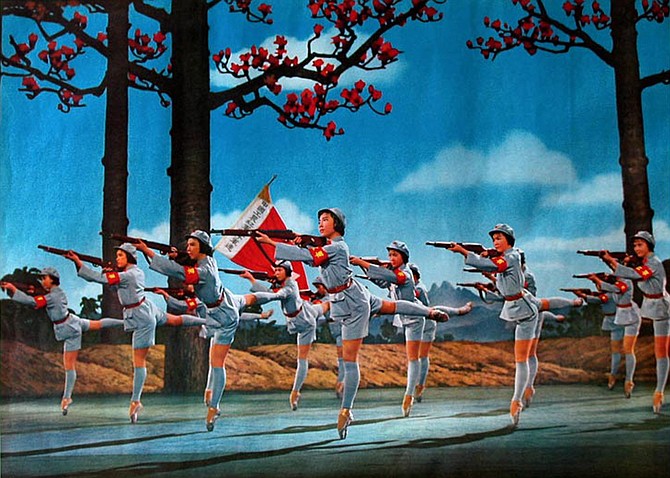 Facebook
Facebook
 X
X
 Instagram
Instagram
 TikTok
TikTok
 Youtube
Youtube

People I’ve talked to about the ballet scene from the end of Act II of Nixon in China have been a little confused. Why is Henry Kissinger writhing on stage and whipping peasant girls to death?
I’ve seen the ballet now about a dozen times. In the original telecast from Houston, Walter Cronkite mentions The Red Detachment of Women before the ballet starts. The Nixons did watch a performance while in China.
The Red Detachment of Women was one of eight model “revolutionary operas” that were approved for China during the Cultural Revolution. The opera was based on a movie which was based on a book. In broad strokes, the story is about a peasant girl who is abused by her local overlord and is saved by communism.
Kissinger portrays the feudal overlord in the Nixon in China version. Why?
Librettist Alice Goodman and composer John Adams appear to be associating Kissinger’s realpolitik with the oppressive conditions that existed before the cultural revolution. During the presentation Pat Nixon says, “He looks like you know who.” This isn’t just a reference to the overlord’s physical appearance as Kissinger but to his abusive actions. The line could read, “He acts like you know who.”
Pat also has another pivotal line in the play. She steps into the presentation of The Red Detachment of Women and consoles the abused girl. This is a representation of her sympathies resting with the abused character. Pat Nixon did not historically go up on stage in China. The abused character represents all of pre-communist China. While Pat is caring for the girl, a male dancer enters as the representation of communism and revives the battered character. Pat says, “Thank God you’ve come.”
Musically and dramatically, this moment is as effective as they come. It is a stunning moment of beauty but without the broader context it doesn't read.
This is the First Lady of the United States saying, “Thank God communism came to China and corrected these atrocities.” What? Yes.
Goodman and Adams are being grown-ups and blurring the traditional line of “United States all good — Communist China all bad.” Immediately following this incident Madame Mao goes berserk and shows her teeth,'''''' bringing us back to the realization that Communist China was certainly not all good either.
This is the maturity we need in our art and our entertainment. It’s not a new idea.
Hindu and Greek mythology are full of divinities and heroes who are both cruel and compassionate. Martin Luther said every human being is both sinner and saint. Each of us in our own lives are both cruel and compassionate.


People I’ve talked to about the ballet scene from the end of Act II of Nixon in China have been a little confused. Why is Henry Kissinger writhing on stage and whipping peasant girls to death?
I’ve seen the ballet now about a dozen times. In the original telecast from Houston, Walter Cronkite mentions The Red Detachment of Women before the ballet starts. The Nixons did watch a performance while in China.
The Red Detachment of Women was one of eight model “revolutionary operas” that were approved for China during the Cultural Revolution. The opera was based on a movie which was based on a book. In broad strokes, the story is about a peasant girl who is abused by her local overlord and is saved by communism.
Kissinger portrays the feudal overlord in the Nixon in China version. Why?
Librettist Alice Goodman and composer John Adams appear to be associating Kissinger’s realpolitik with the oppressive conditions that existed before the cultural revolution. During the presentation Pat Nixon says, “He looks like you know who.” This isn’t just a reference to the overlord’s physical appearance as Kissinger but to his abusive actions. The line could read, “He acts like you know who.”
Pat also has another pivotal line in the play. She steps into the presentation of The Red Detachment of Women and consoles the abused girl. This is a representation of her sympathies resting with the abused character. Pat Nixon did not historically go up on stage in China. The abused character represents all of pre-communist China. While Pat is caring for the girl, a male dancer enters as the representation of communism and revives the battered character. Pat says, “Thank God you’ve come.”
Musically and dramatically, this moment is as effective as they come. It is a stunning moment of beauty but without the broader context it doesn't read.
This is the First Lady of the United States saying, “Thank God communism came to China and corrected these atrocities.” What? Yes.
Goodman and Adams are being grown-ups and blurring the traditional line of “United States all good — Communist China all bad.” Immediately following this incident Madame Mao goes berserk and shows her teeth,'''''' bringing us back to the realization that Communist China was certainly not all good either.
This is the maturity we need in our art and our entertainment. It’s not a new idea.
Hindu and Greek mythology are full of divinities and heroes who are both cruel and compassionate. Martin Luther said every human being is both sinner and saint. Each of us in our own lives are both cruel and compassionate.
Comments